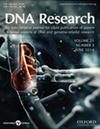Chromosome-level genome assembly of the medicinal insect Blaps rhynchopetera using Nanopore and Hi-C technologies.
IF 2.9
2区 生物学
Q1 GENETICS & HEREDITY
引用次数: 0
Abstract
The Blaps rhynchopetera Fairmaire is a significant medicinal resource in southwestern China. We utilized Nanopore and Hi-C technologies in combination to generate a high-quality, chromosome-level assembly of the B. rhynchopetera genome and described its genetic features. Genome surveys revealed that B. rhynchopetera is a highly heterozygous species. The assembled genome was 379.24 Mb in size, of which 96.03% was assigned to 20 pseudochromosomes. A total of 212.93 Mb of repeat sequences were annotated and 26,824 protein-coding genes and 837 non-coding RNAs were identified. Phylogenetic analysis indicated that the divergence of the ancestors of B. rhynchopetera and its closely related species Tenebrio molitor at about 85.6 mya. The co-linearity analysis showed that some chromosomes of B. rhynchopetera may have happen fission events and it has a good synteny relationship with Tribolium castaneum. Furthermore, in the enrichment analyses, the gene families related to detoxification and immunity of B. rhynchopetera facilitated the understanding its environmental adaptations, which will serve as a valuable research resource for pest control strategies and conservation efforts of beneficial insects. This high-quality reference genome will also contribute to the conservation of insect species diversity and genetic resources.利用 Nanopore 和 Hi-C 技术进行药用昆虫 Blaps rhynchopetera 染色体级基因组组装。
白花蛇舌草是中国西南地区的重要药用资源。我们结合使用了 Nanopore 和 Hi-C 技术,生成了高质量、染色体级的胭脂虫基因组,并描述了其遗传特征。基因组调查显示,B. rhynchopetera 是一个高度杂合的物种。组装的基因组大小为 379.24 Mb,其中 96.03% 被分配到 20 个假染色体上。共注释了 212.93 Mb 的重复序列,鉴定了 26 824 个蛋白质编码基因和 837 个非编码 RNA。系统进化分析表明,菱角虫的祖先与近缘种褐斑天牛的分化时间约为 85.6 mya。共线性分析表明,B. rhynchopetera的部分染色体可能发生过裂变,与Tribolium castaneum具有良好的同源关系。此外,在富集分析中,与菱角蛙解毒和免疫相关的基因家族有助于了解其环境适应性,这将为害虫控制策略和益虫保护工作提供宝贵的研究资源。这一高质量的参考基因组还将有助于保护昆虫物种多样性和遗传资源。
本文章由计算机程序翻译,如有差异,请以英文原文为准。
求助全文
约1分钟内获得全文
求助全文
来源期刊

DNA Research
生物-遗传学
CiteScore
6.00
自引率
4.90%
发文量
39
审稿时长
4.5 months
期刊介绍:
DNA Research is an internationally peer-reviewed journal which aims at publishing papers of highest quality in broad aspects of DNA and genome-related research. Emphasis will be made on the following subjects: 1) Sequencing and characterization of genomes/important genomic regions, 2) Comprehensive analysis of the functions of genes, gene families and genomes, 3) Techniques and equipments useful for structural and functional analysis of genes, gene families and genomes, 4) Computer algorithms and/or their applications relevant to structural and functional analysis of genes and genomes. The journal also welcomes novel findings in other scientific disciplines related to genomes.
 求助内容:
求助内容: 应助结果提醒方式:
应助结果提醒方式:


